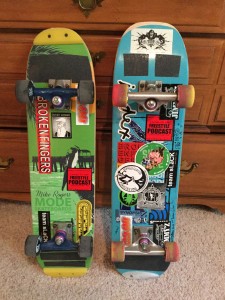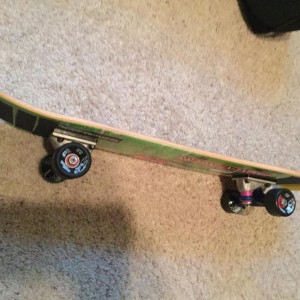I don’t know Mike Rogers. I know a little about him, but I don’t know him. I do know that $5 from the sale of each of these boards goes to Mike’s nonprofit Grind for Life organization.
I do know Terry Synnott, co-owner with his wife Jenna of Mode Skateboards. Terry knows freestyle, and for several years has been producing some of the best FS boards around.
Mike and Terry have gotten together to produce what I would call the first truly modern single-kick flat (non-concave) FS board.
Before I get started with the details, let’s get this out of the way. I love it.
So if my opinion carries any weight with you, that should be enough, and you should also seek mental help, but that’s another issue.
First, the specs:
Length: 28.75”
Width: 7.3”
Nose: 5.5”
Tail: 5.875”
Wheelbase: 13.2”

Compared to the freestyle boards of the 80s, this is a fairly big board. The wheelbase is even fairly long by today’s standards, but not overly so. Anyone could have made a board this shape and size. What makes it special is the combination of the shape, size, and mold.
Let me address the issues of concave, flat nose, and rocker, found in this board.
Concave
The board has a very tiny amount of concave at the very outer edges. Having ridden mine for a while now, I can tell you it is really imperceptible. The board essentially has no concave. Why is this good? Thanks for asking. Let me tell you. It’s easier to move your feet around the board when it is flat. There’s no concave to lock your feet into the middle area of the board. I think it makes more of the deck’s surface useable and less likely to tip over if your foot is near the edge. In a skating discipline that is all about moving your feet all over the board, why would you want your feet locked into the middle? Well, you wouldn’t.
Concave was originally incorporated into vert decks to help keep your feet on the board during the weightless part of vert skating. It works really well for that. Generally, it works really well for street skating. As time passed and the modern popsicle shape became popular, concave came to provide several other benefits. It strengthens the board, making it stiffer, and thus allows a thinner, lighter deck. Concave also provides a great advantage for control of ollie tricks (as does a kick-nose). Finally, with concave there is less friction from the bottom of the board during board slides. No grab/slide rails are needed because of this.
For traditional freestyle, none of this really applies.
So with the the Rogers model having only a tiny amount of concave, you lose some stuff that (for someone like me) will not matter at all. You gain more easy-to-use space on the top of the deck.
Flat Nose
A flat nose is perhaps even more anachronistic than a flat, non-concave, deck. Several very good skaters, such as Mike Osterman, Sean Burke, and others, prefer the non-kick nose. Others I know stuck to the flat nose for a long time, but finally gave up on it — just too much trouble to get a flat-nosed board. I was one of those guys. I have been using double kick FS boards for many years now. None of the single kicks in the last 15 years have appealed to me.
On a recent trip to the UK and Germany, I had a chance to ride Simon Mrozinski’s Mike Rogers model. Simon is a footwork master. He has the kind of footwork smoothness and inventiveness I wish I had, and he was really happy with this board. I took a few rides on Simon’s board, and it was clear that I needed to revisit the flat-nose/flat board experience.
The flat nose will not be for everyone. I will say that it is much much better for casper tricks. If you do the casper standing on the nose, you will be on a much more stable area of the board. It’s just a lot easier to get into, hold, and manipulate the casper if you aren’t standing on a curved surface. Some people are able to adjust to the curve of a double kick for this. I can’t. I’m just not that good. I need all the help I can get. The flat nose gives me that help.
I also think the flat nose is better for rail flips, as long as it has a nice tapered, round shape like that of the Rogers. Again, I need all the help I can get. The flat nose just seems to flip and spin easier than a kick nose. I think it is because it is spinning on the same axis as the rest of the board. Now, I can do rail flips on my Mode double kick. But I found them instantly easier and better on the flat nosed Rogers.
I’ve also found fingerflips somewhat easier on the flat nose. I think this is because 1)I grew up using flat nosed boards, and 2)when you flip the board, the nose is flipping on exactly the same axis as the rest of the board. You don’t have to compensate for the slight incline of the nose.
There are just some tricks for which a flat nose works much better.
Drawbacks. There are some. First, you don’t have quite as much clearance for nose wheelies. It is easier to scrape the nose, so you may need to add a riser or adjust your style a bit. I have not found this to be a huge issue, and nose wheelies are one of my main tricks, but it is an issue none-the-less. Footwork feels different. It too requires some adjustment. I’ve also found my 360 shove-its required some adjustment. It is not quite as easy to just feel for the sweet spot for the front foot. Finally, with one end flat, you have to pay attention with the direction of the board for tricks.
Rocker

Rocker refers to a downward bend in the middle of the board. A gentle curve, like the runners of a rocking chair. In some old boards the amount of rocker was pretty severe.
The Rogers is pressed from a mold that gives it just a tiny hint of rocker. You can see it in this image. Between the trucks the board bows down just slightly. Why would you want this? My friend Tony Gale has asked his question, and my answer of “It feels good” was not enough for him! So here are a couple of other notions. Terry Synnott thinks that the rocker gives you a hint of the upturned nose advantage, without actually having a kick nose. This is true. It makes sense. It is my experience that by very slightly lowering the board in the middle, it creates a little more stability on the way it feels when you stand on it. Back in the old days it was not uncommon for a board to have bit of rocker. Now you find it mostly in downhill boards. The Rogers mold has just enough to give it a really nice feel.
The Result
When you combine the best aspects of old FS shapes with the size of a modern FS board and a proper mold, you have the makings of a great board. This is why I could call this board the first modern flat-nosed, non-concave deck.
I know that Terry and Mike tried many prototypes of this deck, using different molds. Their work has payed off. I hope that many of you will give this deck a try. Board design is really all about trade-offs. Advantages of bigger vs. small, narrow vs. wide, square nose vs. round nose, etc. It is great that Mode is offering a true range of fully modern FS board designs.